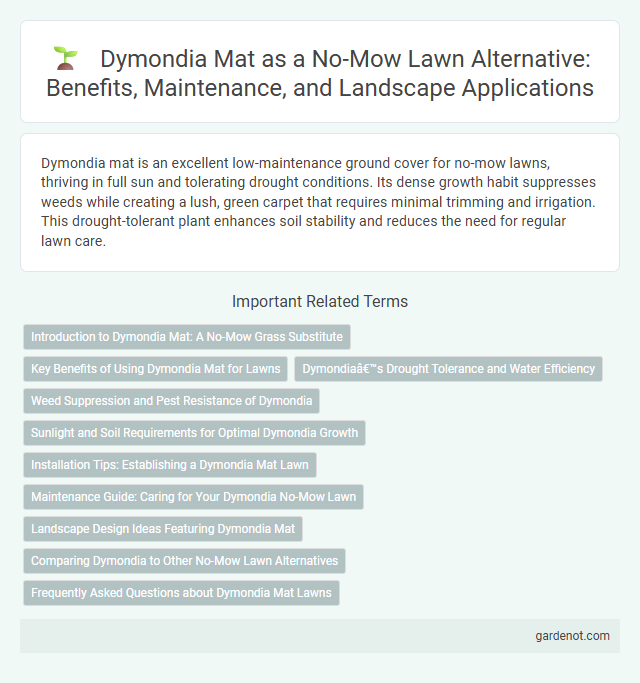Dymondia mat is an excellent low-maintenance ground cover for no-mow lawns, thriving in full sun and tolerating drought conditions. Its dense growth habit suppresses weeds while creating a lush, green carpet that requires minimal trimming and irrigation. This drought-tolerant plant enhances soil stability and reduces the need for regular lawn care.
Introduction to Dymondia Mat: A No-Mow Grass Substitute
Dymondia mat (Dymondia margaretae) is a low-growing, drought-tolerant ground cover that serves as an excellent no-mow grass substitute for lawns. This evergreen plant forms a dense carpet of silvery-green foliage with yellow flowers, requiring minimal maintenance and no regular mowing. Ideal for sunny areas, Dymondia mat improves soil erosion control while reducing water usage and lawn care costs.
Key Benefits of Using Dymondia Mat for Lawns
Dymondia mat offers exceptional drought tolerance and low maintenance, making it an ideal ground cover for no-mow lawns. Its dense, silver-green foliage effectively suppresses weeds and withstands light foot traffic, ensuring a durable and attractive lawn surface. This mat's ability to thrive in poor soil conditions while reducing water usage supports sustainable landscaping practices.
Dymondia’s Drought Tolerance and Water Efficiency
Dymondia mat exhibits exceptional drought tolerance, thriving in arid conditions with minimal water requirements, making it an ideal choice for no-mow lawns in water-scarce regions. Its deep root system efficiently absorbs moisture while reducing evaporation, significantly enhancing water conservation compared to traditional turfgrass. This drought-resilient ground cover maintains vibrant green coloration throughout dry seasons, optimizing landscape sustainability without regular irrigation.
Weed Suppression and Pest Resistance of Dymondia
Dymondia mat excels in weed suppression due to its dense, low-growing foliage that effectively shades out competing plants, reducing the need for herbicides. Its natural pest resistance limits damage from common lawn insects, minimizing pesticide use and enhancing sustainable lawn care. These qualities make Dymondia an ideal choice for a no-mow lawn that demands low maintenance and environmental benefits.
Sunlight and Soil Requirements for Optimal Dymondia Growth
Dymondia mat thrives best in full sun to partial shade, requiring at least 4 to 6 hours of direct sunlight daily for optimal growth. It prefers well-drained sandy or loamy soils with a slightly acidic to neutral pH range of 6.0 to 7.5, ensuring efficient nutrient uptake and root development. Avoid heavy clay soils that retain excess moisture, as this can lead to root rot and hinder plant health.
Installation Tips: Establishing a Dymondia Mat Lawn
Prepare well-drained, sandy or loamy soil with a pH level between 6.0 and 7.5 to establish a thriving Dymondia mat lawn. Space plants 6 to 12 inches apart to promote dense ground cover and efficient mat formation. Water consistently for the first 3 to 4 weeks to encourage deep root growth, then reduce frequency to adapt to drought-tolerant conditions.
Maintenance Guide: Caring for Your Dymondia No-Mow Lawn
Dymondia mat requires minimal maintenance, thriving in full sun with well-drained soil and only occasional watering during dry spells. Regularly trim edges to maintain a neat appearance and remove any weeds promptly to preserve its dense, low-growing habit. Fertilize lightly once or twice a year with a balanced, slow-release fertilizer to promote vibrant green color and healthy growth.
Landscape Design Ideas Featuring Dymondia Mat
Dymondia mat offers a low-maintenance, drought-tolerant ground cover ideal for no-mow lawn alternatives, creating a lush, green carpet that thrives in full sun and poor soils. Its dense, silver-green foliage suppresses weeds, providing an eco-friendly solution for sustainable landscape design while adding texture and color contrast around pathways, garden beds, and rock features. Incorporating Dymondia mat into landscape projects enhances curb appeal and reduces water usage, making it perfect for xeriscaping and urban garden environments.
Comparing Dymondia to Other No-Mow Lawn Alternatives
Dymondia mat offers a dense, low-growing ground cover that thrives in full sun and drought conditions, outperforming many common no-mow lawn alternatives like clover and sedum by requiring less water and maintenance. Unlike creeping thyme, which can struggle in high-traffic areas, Dymondia's tough growth habit tolerates foot traffic, making it suitable for pathways and garden borders. Its silver-green foliage also provides a unique aesthetic contrast to the usual green hues found in other ground covers, enhancing both functionality and visual appeal.
Frequently Asked Questions about Dymondia Mat Lawns
Dymondia mat is a low-maintenance ground cover ideal for no-mow lawns, thriving in full sun and well-drained soil with drought tolerance once established. This mat-forming plant resists foot traffic and weeds, making it a popular choice for sustainable landscaping and erosion control. Regular watering during establishment and occasional trimming keep the Dymondia mat dense and healthy without the need for mowing.
Dymondia mat Infographic

 gardenot.com
gardenot.com